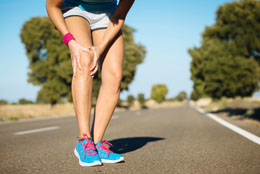This article deals with the various aspects of osteoarthritis treatment and management. Prevention is the best cure for degenerative arthritis, and it should start in early adulthood. Though we cannot stop aging, it's important to stop premature and disabled aging caused by joint problems.

Osteoarthritis is a degenerative form of arthritis occurring at middle age due to the wear and tear of the joints. It is a normal physiological part of the aging process. Almost every person suffers from this type of arthritis in a milder or severe form depending upon the precipitating factors. Basically, osteoarthritis means the loss of cartilage between the bones of the affected joints.
Obesity, overuse of the joints, age, genetics, gender (women are more likely to develop arthritis), trauma are considered to be some of the general risk factors. Common sites to be affected are knee, hip, spine and small joints of the hands. Pain and stiffness that increases with activity are the main symptoms of osteoarthritis. Swelling and joint instability may also be a symptom in some cases.
The changes in the articular cartilage being irreversible, osteoarthritis can only be controlled and further thinning of cartilage can be arrested. In some cases pain-free condition can be achieved by combination of treatments.
Treatment of Osteoarthritis
Arthritis Medications
Arthritis medications need to be individualized for every person. Analgesics, NSAID's, and COX-2 inhibitors are the painkillers used for joint pain relief to ensure mobility in the aching joints. Calcium and mineral supplements can be used to reduce osteoporosis. Some nutritional supplements like glucosamine and chondroitin sulfate are used to minimize cartilage destruction.
Local Therapy
Topical creams and liniments can be used for pain relief. They provide temporary relief as they act superficially by relieving the pain in the muscle. Heat therapy is used for muscle relaxation and relieves the aching joints. Heat application is contra-indicated if the joints are swollen. Cold application helps to reduce the pain in such joints.
Intra-articular Treatments
Intra-articular corticosteroids can be administered in severe cases of joint pain and inflammation, but long-term and repetitive use should not be encouraged.
Physiotherapy and Exercises
Physiotherapy helps in reducing pain, stiffness and improves muscle strength and mobility of joints. Muscle strengthening exercises need to be done stringently, to support the affected joint. Excessive stress on the joints should be avoided while exercising, as it might aggravate further degeneration of the cartilage.
Weight Loss
Weight loss is the most effective way to treat this condition. Overweight individuals tend to put a lot of pressure on the knee, back and hip joints; this further accelerates the degeneration of the cartilage. Taking off the extra kilos can significantly arrest the cartilage thinning process.
Living with Osteoarthritis
Patient education is a very important aspect of arthritis management. The patient needs to be educated about the dos and don'ts in daily activities. Squatting, kneeling, prolonged standing, sitting cross-legged, lifting heavy weights should be avoided. Regular Exercises, weight maintenance and medications need to be strictly followed. Different types of braces and aids for the knees and spine can be used for supporting the affected joints.
Surgical Management
Advanced osteoarthritis needs surgical treatment like arthroscopy, osteotomy, or a total joint replacement surgery.
Prevention
Prevention is the best cure and it should start in early adulthood. Though we can't stop aging, it's important to stop premature and disabling aging. Moderate muscle strengthening exercises should be done regularly. Healthy weight should be maintained with the help of exercises, and it's necessary to adopt a balanced diet. A healthy diet would help keep the excess weight off our joints thus reducing undue stress on them. Sports injury and other minor injuries should be prevented.


 Osteoarthritis is a degenerative form of arthritis occurring at middle age due to the wear and tear of the joints. It is a normal physiological part of the aging process. Almost every person suffers from this type of arthritis in a milder or severe form depending upon the precipitating factors. Basically, osteoarthritis means the loss of cartilage between the bones of the affected joints.
Osteoarthritis is a degenerative form of arthritis occurring at middle age due to the wear and tear of the joints. It is a normal physiological part of the aging process. Almost every person suffers from this type of arthritis in a milder or severe form depending upon the precipitating factors. Basically, osteoarthritis means the loss of cartilage between the bones of the affected joints.